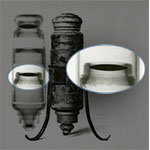A microscope is usually composed of the following functional parts:
Carrying structure of the microscope that supports or incorporates the optical and mechanical parts. Originally consisting of a tripod, the stand has successively taken the shape of a side-pillar, and, in modern microscopes, a C-shaped metal arc.
Plane or concave mirror, placed on the microscope base and used to send light onto the specimen and into the microscope optics. The mirror is mounted on a swiveling support, adjusted to reflect natural light or light from an artificial source in the desired direction.
Lens that concentrates the light on the specimen, making it brighter and easier to observe. In particular, the Abbe "condenser" produces an image of an extended, uniform source compatible with the specimen. Techniques to concentrate light on the specimen include Köhler illumination and the dark-field method.
Flat surface for holding the specimen. Often fitted with movements, to bring the sector of interest for the observation into the center of the field of view.
System for varying the distance between the objective and the stage, in order to obtain a sharp ("focused") image. Sometimes divided into a coarse-focus mechanism, with a long but rough adjustment, and a fine-focus mechanism, with a shorter but more gradual run.
Converging optical system with short focal length (typically, under 40 mm) and wide light-gathering angle (numerical aperture exceeding 0.1) that forms an enlarged, upside-down image of the object observed. Comprises several lenses, combined to correct aberrations. Categories of objectives include: "achromatic," i.e., removing spherical and primary chromatic aberration; "apochromatic," for even greater correction of chromatic aberration; and "plane-field," i.e., corrected for field curvature. Objectives functioning in normal environmental conditions (in air) are called "dry." To increase the light-gathering angle there are "immersion" objectives designed for use with a coupling fluid (typically, a droplet of oil) between the specimen and the objective.
Eccentric revolving device (also called nosepiece or turret) with various threaded holes for inserting the objectives. Allows quick change of objectives simply by turning the eccentric. This shortens the interval between observations.
Prism that splits the optical axis of the microscope, tilting it to a comfortable viewing angle for the observer. Usually functions as a pair of plane mirrors that send the light through the objective to the eyepiece. May consist of a more complex optical system when the purpose is to double the image, sending it to a pair of eyepieces, or to allow the use of a still-camera body or a video camera.
Lens (or lens system) with which the eye observes the image formed by the objective. The eyepiece provides a magnification, as in a simple microscope. Eyepieces, like objectives, are interchangeable (they are removed and replaced directly); the microscope's overall magnification power is the product of the objective magnification and the eyepiece magnification. When using the microscope, the observer brings his or her eye up to the eyepiece. There is an optimal position for the observation, known as the "exit pupil." When the eye is in that position, it received the maximum amount of light and can observe the entire visual field of the instrument. The distance of the exit pupil from the eyepiece is the "pupil extraction." For comfortable viewing, the pupil extraction should not be less than 1 cm. In its simplest form, the eyepiece consists of a single converging lens, of short focal length: the "eye lens."
To widen the visual field, one can place a second converging lens near the image formed by the objective: the "field lens," or "collecting lens." It tilts the more peripheral light beams toward the optical axis, causing them to enter the eye-lens aperture. However, this reduces the pupil extraction.
This eyepiece, named after its inventor, Christiaan Huygens (1629-95), consists of the eye lens and the field lens; both are plane-convex, with the plane side facing the observer's eye. The region where the image forms lies between the two lenses, precluding the insertion of a crosshair or reticule. Other types of eyepiece are the Ramsden eyepiece and the Kellner eyepiece. Magnifications typically range between 5x and 15x.








